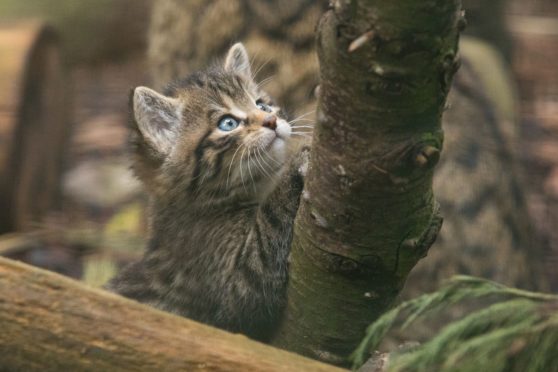New research has concluded there is “no longer a viable wildcat population living wild in Scotland”.
Breeding with domestic cats is a major threat to the survival of Scotland’s genetically-pure wildcats – the most endangered species in the UK – according to the study.
Scottish Wildcat Action (SWA) now wants a “national conversation” on responsible cat ownership.
It has also recommended captive breeding of pure wildcats at National Wildlife Reintroduction Centre in the Cairngorms and releasing them into the wild.
The International Union for the Conservation of Nature (IUCN), which was commissioned by SWA to review Scotland’s wildcat conservation efforts, said hybridisation was the major threat to the animals’ survival.
>> Keep up to date with the latest news with The P&J newsletter
SWA, a group whose members include Scottish Natural Heritage (SNH) and Royal Zoological Society of Scotland (RZSS), said managing domestic cats was important to its conservation efforts.
Eileen Stuart, head of policy and advice at SNH, said: “The public will have an important role in helping minimise future hybridisation.
“Responsible cat ownership – including microchipping, neutering and vaccinations – is one way we can help reduce the devastating effects on wildcats.”
David Barclay, cat conservation project officer at RZSS, said helping the Scottish wildcat population to recover would be challenging.
He said: “Our plans for a National Wildlife Reintroduction Centre will provide the perfect environment for breeding genetically tested wildcats with the aim of releasing them back into the wild to re-establish viable populations in key locations.
“Combined with the continued development of the conservation breeding programme, this will ensure we have a long-term solution for the recovery and conservation of this iconic species.”
Mr Barclay added: “Together we can restore Scotland’s wildcats to their rightful place as an integral link in a thriving ecosystem.”
The centre would be based at RZSS Highland Wildlife Park near Kincraig.
Environment secretary Roseanna Cunningham said the IUCN’s review, outlined yesterday, presented further evidence of the “serious challenges” that wildcat conservation faces in Scotland.
She said: “The wildcat is an iconic Scottish species and, as such, I will consider every possible action the Scottish government can take to save it.
“We have in place a partnership of scientists and specialists with the knowledge and expertise to give us the best chance of restoring the ‘Highland tiger’ as a distinctive and charismatic species in the Scottish countryside.”
SWA’s work is separate from the Wildcat Haven project which involves establishing reserves in areas where wildcats are found and also neutering and vaccinating pet cats.
Scottish Wildcat Action steering group chairman, Dr Andrew Kitchener, Principal Curator of Vertebrates at National Museums Scotland, said: “We now have the strongest and most reliable evidence to date that wildcats are in a more endangered state than previously understood.
“While we believe there are wildcats remaining in the wild in Scotland, there are no longer enough to ensure their continued survival as viable populations. We can now plan the essential next steps to give the wildcat a sustainable future.”
